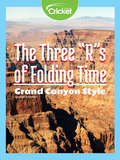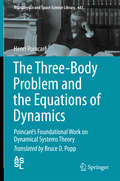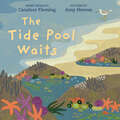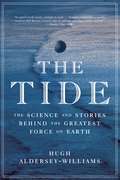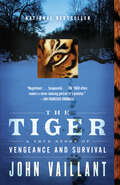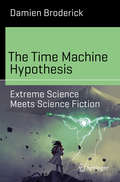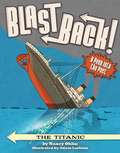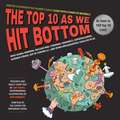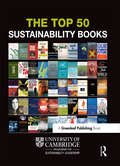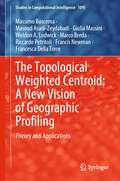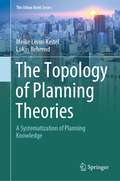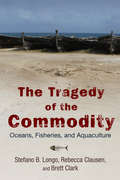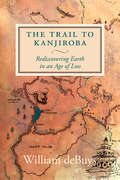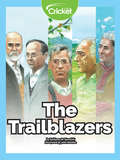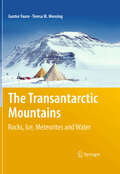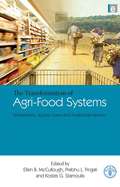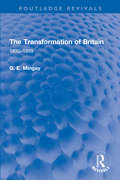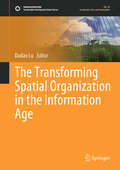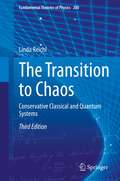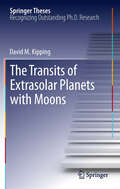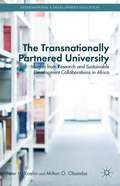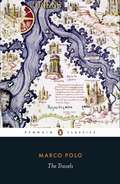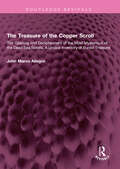- Table View
- List View
The Three R's of Folding Time Grand Canyon Style
by Leigh AndersonHave you ever visited the Grand Canyon? As one of the world’s seven wonders, millions of people have visited this landmark. Have you ever wondered how it was formed? Learn how the 3 "R"s- Rock, Rivers, & Erosion, have led to the formation of the Grand Canyon and the changes it undergoes in present day. Discover whether how the canyon will continue to grow and change in the future. This lesson in geology gives insight to the phenomena that has created one of the Earth's greatest landmarks.
The Three Sustainabilities: Energy, Economy, Time
by Allan StoeklBringing the word sustainability back from the brink of cliché—to a substantive, truly sustainable future Is sustainability a hopelessly vague word, with meager purpose aside from a feel-good appeal to the consumer? In The Three Sustainabilities, Allan Stoekl seeks to (re)valorize the word, for a simple reason: it is useful. Sustainability designates objects in time, their birth or genesis, their consistency, their survival, their demise. And it raises the question, as no other word does, of the role of humans in the survival of a world that is quickly disappearing—and perhaps in the genesis of another world. Stoekl considers a range of possibilities for the word, touching upon questions of object ontology, psychoanalysis, urban critique, technocracy, and religion. He argues that there are three varieties of sustainability, seen from philosophical, cultural, and economic perspectives. One involves the self-sustaining world &“without us&”; another, the world under our control, which can run the political spectrum from corporatism to Marxism to the Green New Deal; and a third that carries a social and communitarian charge, an energy of the &“universe&” affirmed through, among other things, meditation and gifting. Each of these carves out a different space in the relations between objects, humans, and their survival and degradation. Each is necessary, unavoidable, and intimately bound with, and infinitely distant from, the others.Along the way, Stoekl cites a wide range of authors, from philosophers to social thinkers, literary theorists to criminologists, anthropologists to novelists. This beautifully written, compelling, and nuanced book is a must for anyone interested in questions of ecology, energy, the environmental humanities, contemporary theories of the object, postmodern and posthuman aesthetics, or religion and the sacred in relation to community.
The Three-Body Problem and the Equations of Dynamics
by Henri Poincaré Bruce D PoppHere is an accurate and readable translation of a seminal article by Henri Poincaré that is a classic in the study of dynamical systems popularly called chaos theory. In an effort to understand the stability of orbits in the solar system, Poincaré applied a Hamiltonian formulation to the equations of planetary motion and studied these differential equations in the limited case of three bodies to arrive at properties of the equations’ solutions, such as orbital resonances and horseshoe orbits. Poincaré wrote for professional mathematicians and astronomers interested in celestial mechanics and differential equations. Contemporary historians of math or science and researchers in dynamical systems and planetary motion with an interest in the origin or history of their field will find his work fascinating.
The Tide Pool Waits
by Candace FlemingDive into the rich ecology of tide pools and watch a hidden world spring in this masterful nonfiction picture book for very young readers. <P><P> Twice a day when the tide goes out, an astonishing world is revealed in the tide pools that form along the Pacific Coast. <P><P> Some of the creatures that live here look like stone. Others look like plants. Some move so slowly it’s hard to tell if they’re moving at all, while others are so fast you’re not sure you really saw them. The biggest animals in the pool are smaller than your hand, while the smallest can’t be seen at all without a microscope. <P><P> During low tide, all these creatures – big, small, fast, slow – are exposed to air and the sun’s drying heat. And so they have developed ways to survive the wait until the ocean’s return. <P><P> Candace Fleming is the author of Honeybee, which received an Orbis Pictus Honor and 7 starred reviews. She brings her knack for making science and nature appealing to the very young in The Tidepool Waits with detailed accounts of dozens of species of sea life, culminating in a perfect primer for students and nature lovers taking their first trip to the shore. Her text is accompanied by effervescent artwork by Amy Hevron and substantial backmatter. <P><P><i>Advisory: Bookshare has learned that this book offers only partial accessibility. We have kept it in the collection because it is useful for some of our members. Benetech is actively working on projects to improve accessibility issues such as these.</i>
The Tide: The Science and Stories Behind the Greatest Force on Earth
by Hugh Aldersey-WilliamsA rich and sweeping exploration into the science and history behind the most mysterious, primal, and powerful force on earth: the tide. Half of the world’s population today lives in coastal regions lapped by tidal waters. But the tide rises and falls according to rules that are a mystery to almost all of us. In The Tide, celebrated science writer Hugh Aldersey-Williams weaves together centuries of scientific thinking with the literature and folklore the tide has inspired to explain the power and workings of this most remarkable force. Here is the epic story of the long search to understand the tide: from Aristotle, who is said to have drowned himself in his efforts to figure out the Greek tides, to the pioneering investigations into the role of the moon by Galileo and Newton, to the quest to understand and even control the tide in our own time. Throughout, Aldersey-Williams whisks the reader along on his travels in search of the most remarkable tidal phenomena. He visits the Bay of Fundy in Nova Scotia, where the tides are the strongest in the world; arctic Norway, home of the raging tidal whirlpool known as the maelstrom; and Venice, to investigate efforts to defend the city against flooding caused by the famed acqua alta. Along the way, Aldersey-Williams delves into classic literary portrayals of the tide from Shakespeare to Dickens, Melville to Jules Verne. And he reveals the tidal truths behind the Homeric tale of Scylla and Charybdis, the biblical story of Moses parting the Red Sea, the conquests of Julius Caesar, the Boston Tea Party, and the D-Day landings in Normandy.
The Tiger: A True Story of Vengeance and Survival (Vintage Departures Ser.)
by John VaillantNATIONAL BESTSELLER • A gripping story of man pitted against nature&’s most fearsome and efficient predator. This "travelogue about tiger poaching in Russia&’s far east opens up a new genre ... [the] conservation thriller" (Nature).Outside a remote village in Russia&’s Far East a man-eating tiger is on the prowl. The tiger isn&’t just killing people, it&’s murdering them, almost as if it has a vendetta. A team of trackers is dispatched to hunt down the tiger before it strikes again. They know the creature is cunning, injured, and starving, making it even more dangerous. As John Vaillant re-creates these extraordinary events, he gives us an unforgettable and masterful work of narrative nonfiction that combines a riveting portrait of a stark and mysterious region of the world and its people, with the natural history of nature&’s most deadly predator.
The Time Machine Hypothesis: Extreme Science Meets Science Fiction (Science and Fiction)
by Damien BroderickEvery age has characteristic inventions that change the world. In the 19th century it was the steam engine and the train. For the 20th, electric and gasoline power, aircraft, nuclear weapons, even ventures into space. Today, the planet is awash with electronic business, chatter and virtual-reality entertainment so brilliant that the division between real and simulated is hard to discern. But one new idea from the 19th century has failed, so far, to enter reality—time travel, using machines to turn the time dimension into a two-way highway. Will it come true, as foreseen in science fiction? Might we expect visits to and from the future, sooner than from space? That is the Time Machine Hypothesis, examined here by futurist Damien Broderick, an award-winning writer and theorist of the genre of the future. Broderick homes in on the topic through the lens of science as well as fiction, exploring some fifty different time-travel scenarios and conundrums found in the science fiction literature and film.
The Titanic (Blast Back!)
by Adam Larkum Nancy OhlinYou may have heard of the movie Titanic, but what was life on the actual Titanic really like? This engaging nonfiction book, complete with black and white interior illustrations, will make readers feel like they've traveled back in time. It covers everything from how the ship was built to what the passengers did for fun, and more. Find out interesting, little-known facts such as how the anchor was so heavy that they needed to use twenty horses to lift it and how the ship's musicians continued to play as the ship sank. The unique details, along with the clever illustrations, make this series stand out from the competition.
The Top 10 As We Hit Bottom: What Global Warming, Nuclear War, Cyberwar, Pandemics, Supervolcanoes, Asteroid Strikes, Out-of-Control A.I., and Other Unpleasantries Could Do to Us.
by Jim ParryFrom best-selling author and illustrator Ron Barrett, who forecasted the weather in the classic picture book, Cloudy With a Chance of Meatballs, now predicts how—thanks to climate change and other unpleasantries—the world will end! With research and really scary text by Jim Parry, The Top Ten As We Hit Bottom is a darkly humorous collection of &“Top Ten&” lists that highlights the predicament global warming and other impending catastrophes have put us into. Though some might call these lists &“fake news&” (we&’re looking at you, Donald), these lists are compiled and culled from the world's most credible authorities like NASA, the UN, and the Union of Concerned Scientists. But coupled with darkly humorous illustrations, you&’ll be laughing your way all the way down in our race toward the bottom! Here are some Top 10 lists to whet your appetite for Earth&’s impending doom: &“Top 10 species we&’ll lose to climate change&”&“Top 10 avalanches mostly caused by global warming&”&“Top 10 climate change deniers&”&“Top 10 times we almost had a nuclear war,&”&“Top 10 things that will happen when the Yellowstone Supervolcano erupts,&”&“Top 10 ways to try to stop an asteroid,&”&“Top 10 signs that the earth is about to be swallowed by a black hole,&”&“Top 10 ways a particle accelerator mishap could destroy the world,&”&“Top 10 end-of-world cults you can join now.&”And many more!
The Top 50 Sustainability Books
by Wayne VisserThis unique title draws together in one volume some of the best thinking to date on the pressing social and environmental challenges we face as a society. These are the Top 50 Sustainability Books as voted for by the University of Cambridge Programme for Sustainability Leadership's alumni network of over 3,000 senior leaders from around the world. In addition to profiles of all 50 titles, many of the authors share their most recent reflections on the state of the world and the ongoing attempts by business, government and civil society to create a more sustainable future. Many of these authors have become household names in the environmental, social and economic justice movements – from Rachel Carson, Ralph Nader and E.F. Schumacher to Vandana Shiva, Muhammad Yunus and Al Gore. Others, such as Aldo Leopold, Thomas Berry and Manfred Max-Neef, are relatively undiscovered gems, whose work should be much more widely known. By featuring these and other seminal thinkers, The Top 50 Sustainability Books distils a remarkable collective intelligence – one that provides devastating evidence of the problems we face as a global society, yet also inspiring examples of innovative solutions; it explores our deepest fears and our highest hopes for the future. It is a must-read for anyone who wants to tap into the wisdom of our age.
The Topological Weighted Centroid: Theory and Applications (Studies in Computational Intelligence #1095)
by Massimo Buscema Weldon A. Lodwick Giulia Massini Marco Breda Francis Newman Masoud Asadi-Zeydabadi Riccardo Petritoli Francesca Della TorreThis book introduces the Topological Weighed Centroid approach and describes some applications in the study of the dynamics of various spatial phenomena with a special emphasis on the spatial analysis of the relationship, influence, and dynamics of geographical phenomena. Offering a comprehensive introduction to the theory and illustrative examples from various kinds of geographical data, this book also takes an in-depth look at more complex case studies, such as the applications of the topological weighed centroid approach in the study of epidemic patterns, cultural processes, criminality, and environmental phenomena.
The Topology of Planning Theories: A Systematization of Planning Knowledge (The Urban Book Series)
by Meike Levin-Keitel Lukas BehrendThe book discusses and organizes planning theories in a new way. Building on a foundation in scientific theory, both planning practice and the planning sciences are thereby classified and their inherent importance is organized in terms of knowledge generation. The core of the book is a knowledge-oriented systematization of planning knowledge in the form of planning theories, the topology of planning theories. The target audience of this work are academic as well as practical users from diverse disciplines with spatial impact, such as spatial planning, urban planning, regional planning, landscape planning, geography, urban studies, architecture and landscape architecture.
The Tornado Scientist: Seeing Inside Severe Storms (Scientists in the Field Series)
by Mary Kay CarsonIn this addition to the critically-acclaimed Scientist in the Field series, scientist Robin Tanamachi and her team are trying to save countless lives across America’s heartland, chasing one tornado at a time. Robin Tanamachi has been captivated by tornadoes and extreme weather her entire life. When she realized people researched weather for a job, she was hooked. She now studies tornadogenesis, or how tornadoes form, and what causes them to get weaker versus strengthen. For her, driving around in a Doppler radar truck aiming towards storms is a normal day in the office. The data she collects is then modeled and studied on computers—with math, physics, and computer science working hand in hand with meteorology. At the end of the day, knowing exactly how, when, and where these violent storms happen can give more warning time for everyone involved.
The Tragedy of the Commodity
by Stefano B. Longo Rebecca Clausen Brett ClarkAlthough humans have long depended on oceans and aquatic ecosystems for sustenance and trade, only recently has human influence on these resources dramatically increased, transforming and undermining oceanic environments throughout the world. Marine ecosystems are in a crisis that is global in scope, rapid in pace, and colossal in scale. In The Tragedy of the Commodity, sociologists Stefano B. Longo, Rebecca Clausen, and Brett Clark explore the role human influence plays in this crisis, highlighting the social and economic forces that are at the heart of this looming ecological problem. In a critique of the classic theory "the tragedy of the commons" by ecologist Garrett Hardin, the authors move beyond simplistic explanations--such as unrestrained self-interest or population growth--to argue that it is the commodification of aquatic resources that leads to the depletion of fisheries and the development of environmentally suspect means of aquaculture. To illustrate this argument, the book features two fascinating case studies--the thousand-year history of the bluefin tuna fishery in the Mediterranean and the massive Pacific salmon fishery. Longo, Clausen, and Clark describe how new fishing technologies, transformations in ships and storage capacities, and the expansion of seafood markets combined to alter radically and permanently these crucial ecosystems. In doing so, the authors underscore how the particular organization of social production contributes to ecological degradation and an increase in the pressures placed upon the ocean. The authors highlight the historical, political, economic, and cultural forces that shape how we interact with the larger biophysical world. A path-breaking analysis of overfishing, The Tragedy of the Commodity yields insight into issues such as deforestation, biodiversity loss, pollution, and climate change.
The Trail to Kanjiroba: Rediscovering Earth in an Age of Loss
by William deBuysA revitalizing new perspective on Earthcare from Pulitzer Prize finalist William deBuys.In 2016 and 2018 acclaimed author and conservationist William deBuys joined extended medical expeditions into Upper Dolpo, a remote, ethnically Tibetan region of northwestern Nepal, to provide basic medical services to the residents of the region. Having written about climate change and species extinction, deBuys went on those journeys seeking solace. He needed to find a constructive way of living with the discouraging implications of what he had learned about the diminishing chances of reversing the damage humans have done to Earth; he sought a way of holding onto hope in the face of devastating loss. As deBuys describes these journeys through one of Earth's remotest regions, his writing celebrates the land&’s staggering natural beauty, and treats his readers to deep dives into two scientific discoveries—the theories of natural selection and plate tectonics—that forever changed human understanding of our planet. Written in a vivid and nuanced style evocative of John McPhee or Peter Matthiessen, The Trail to Kanjiroba offers a surprising and revitalizing new way to think about Earthcare, one that may enable us to continue the difficult work that lies ahead.
The Trailblazers
by Kathiann M. KowalskiHere's how a few pioneers forged their own unique paths in the conservation movement.
The Transantarctic Mountains
by Gunter Faure Teresa M. MensingThis book presents a summary of the geology of the Transantarctic Mountains for Earth scientists who may want to work there or who need an overview of the geologic history of this region. In addition, the properties of the East Antarctic ice sheet and of the meteorites that accumulate on its surface are treated in separate chapters. The presentation ends with the Cenozoic glaciation of the Transantarctic Mountains including the limnology and geochemical evolution of the saline lakes in the ice-free valleys. * The subject matter in this book is presented in chronological order starting about 750 million years ago and continuing to the present time. * The chapters can be read selectively because the introduction to each chapter identifies the context that gives relevance to the subject matter to be discussed. * The text is richly illustrated with 330 original line drawings as well as with 182 color maps and photographs. * The book contains indexes of both subject matter and of authors' names that allow it to be used as an encyclopedia of the Transantarctic Mountains and of the East Antarctic ice sheet. * Most of the chapters are supplemented by Appendices containing data tables, additional explanations of certain phenomena (e.g., the formation and seasonal destruction of stratospheric ozone), and illustrative calculations (e.g., 38Cl dates of meteorites). * The authors have spent a combined total of fourteen field seasons between 1964 and 1995 doing geological research in the Transantarctic Mountains with logistical support by the US Antarctic Program. * Although Antarctica is remote and inaccessible, tens of thousands of scientists of many nationalities and their assistants have worked there and even larger numbers of investigators will work there in the future.
The Transformation of Agri-Food Systems: Globalization, Supply Chains and Smallholder Farmers
by Ellen B. McCullough Prabhu L. Pingali Kostas G. Stamoulis'There should be a good market for this book. The topic is very timely and a major theme of the new World Development Report 2008. The editors and contributors are world class.' Derek Byerlee, World Bank 'This is a topic of wide interest and high policy importance. The depth of coverage and excellent synthesis should ensure that the book will have a substantial market in high-level undergraduate and graduate courses in agricultural development. It will have a solid readership among development economists and policy makers as well.' Mark Rosegrant, International Food Policy Research Institute The driving forces of income growth, demographic shifts, globalization and technical change have led to a reorganization of food systems from farm to plate. The characteristics of supply chains - particularly the role of supermarkets - linking farmers have changed, from consumption and retail to wholesale, processing, procurement and production. This has had a dramatic effect on smallholder farmers, particularly in developing countries. This book presents a comprehensive framework for assessing the impacts of changing agri-food systems on smallholder farmers, recognizing the importance of heterogeneity between developing countries as well as within them. The book includes a number of case studies from Asia, Africa, Latin America and Eastern Europe, which are used to illustrate differences in food systems' characteristics and trends. The country case studies explore impacts on the small farm sector across different countries, local contexts and farm types. Published with FAO
The Transformation of Britain: 1830–1939 (Routledge Revivals)
by G. E. MingayFirst published in 1986, The Transformation of Britain, 1830–1939 delves into the significant changes that occurred across the landscape and society of Britain during this prominent age of reform and innovation. The book traces the rapid increase in the pace and scale of change across Britain, and explores the key developments that occurred. It examines the changes in population as more people moved towards towns and cities; the growth in industry and trade and the resultant demand for methods of communication and transport; and the technological advancements in all areas of life. It highlights the impact that these changes left on the landscape of Britain, such as through the building of roads and railways, as well as on Britain’s social structure. It also considers the extent to which this crucial period shaped the successes and problems of modern Britain. The Transformation of Britain, 1830–1939 will appeal to those with an interest in the social and industrial history of Britain.
The Transforming Spatial Organization in the Information Age (Sustainable Development Goals Series)
by Dadao LuThis book provides a critical account, a state-of-the-art review, as well as novel research methods of information technology development and the corresponding changes of socio-economic spatial organization in China.With the rapid development of the Internet over the past three decades, the development of information technology and its impact on social economy have become an important frontier issue of human and economic geography. Actually, the influence of information technology is complex and dynamic, involving almost all aspects of socio-economic activities and our daily life. It is also influencing the methods and disciplines that we use to understand it. In general, industrial development and regional management and innovation are the core contents of socio-economic spatial organization. Therefore, changes in industrial clusters, transportation logistics, regional development and innovation, urban planning and management, and rural development under the background of the information age were analysed to understand the relationship among information revolution, socio-economic spatial organization, and human and economic geography.Primarily intended for scholars and graduate students across a range of disciplines, such as geography, urban-rural planning, information science, urban science, economics and sociology, and people engaged in regional planning, urban management and information management, this book proves to be an innovative and up-to-date resource.
The Transition to Chaos: Conservative Classical and Quantum Systems (Fundamental Theories of Physics #200)
by Linda ReichlBased on courses given at the universities of Texas and California, this book treats an active field of research that touches upon the foundations of physics and chemistry. It presents, in as simple a manner as possible, the basic mechanisms that determine the dynamical evolution of both classical and quantum systems in sufficient generality to include quantum phenomena. The book begins with a discussion of Noether's theorem, integrability, KAM theory, and a definition of chaotic behavior; continues with a detailed discussion of area-preserving maps, integrable quantum systems, spectral properties, path integrals, and periodically driven systems; and concludes by showing how to apply the ideas to stochastic systems. The presentation is complete and self-contained; appendices provide much of the needed mathematical background, and there are extensive references to the current literature; while problems at the ends of chapters help students clarify their understanding. This new edition has an updated presentation throughout, and a new chapter on open quantum systems.
The Transits of Extrasolar Planets with Moons
by David M. KippingCan we detect the moons of extrasolar planets? For two decades, astronomers have made enormous progress in the detection and characterisation of exoplanetary systems but the identification of an "exomoon" is notably absent. In this thesis, David Kipping shows how transiting planets may be used to infer the presence of exomoons through deviations in the time and duration of the planetary eclipses. A detailed account of the transit model, potential distortions, and timing techniques is covered before the analytic forms for the timing variations are derived. It is shown that habitable-zone exomoons above 0.2 Earth-masses are detectable with the Kepler space telescope using these new timing techniques.
The Transnationally Partnered University
by Peter H. Koehn Milton O. ObambaAnalyzing the growing importance of the transnational higher education landscape and the role of African universities, Koehn and Obamba show how transnational partnerships among universities can inform policy, strengthen synergies between knowledge producers and knowledge users, and advance sustainable-development practice.
The Travels
by Marco Polo Nigel CliffA sparkling new translation of one of the greatest travel books ever written- Marco Polo's seminal account of his journeys in the east. Marco Polo was the most famous traveller of his time. His voyages began in 1271 with a visit to China, after which he served the Kublai Khan on numerous diplomatic missions. On his return to the West he was made a prisoner of war and met Rustichello of Pisa, with whom he collaborated on this book. His account of his travels offers a fascinating glimpse of what he encountered abroad- unfamiliar religions, customs and societies; the spices and silks of the East; the precious gems, exotic vegetation and wild beasts of faraway lands. Evoking a remote and long-vanished world with colour and immediacy, Marco's book revolutionized western ideas about the then unknown East and is still one of the greatest travel accounts of all time. For this edition - the first completely new English translation of the Travels in over fifty years - Nigel Cliff has gone back to the original manuscript sources to produce a fresh, authoritative new version. The volume also contains invaluable editorial materials, including an introduction describing the world as it stood on the eve of Polo's departure, and examining the fantastical notions the West had developed of the East.
The Treasure of the Copper Scroll: The Opening and Decipherment of the Most Mysterious of the Dead Sea Scrolls, A Unique Inventory of Buried Treasure (Routledge Revivals)
by John Marco AllegroFirst published in 1960, The Treasure of the Copper Scroll is the companion volume to John Marco Allegro’s People of the Dead Sea Scrolls and tells the story of this unusual, buried treasure. Allegro here reveals much hitherto unknown information – the location of many of the cities of the Old Testament, events of the second Jewish Revolt, and the relation between the Essene community at Qumran and the New Testament interest in healing. With facsimiles of the scroll, translations of its texts, and a thorough discussion of its significance, with maps indicating many of the probable present-day hiding places, the book is a truly fascinating report on this unusual document and a first long step toward the unravelling of its secrets.
